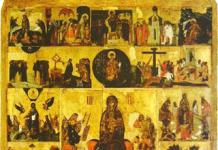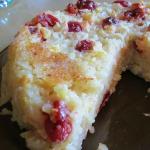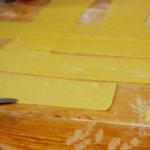Municipal budgetary educational institution
Doschatinskaya Secondary School
urban district of Vyksa, Nizhny Novgorod region
Solving logical problems.
Department of Physics and Mathematics
Math section
I've done the work:
5th grade student
Papotina Elena Sergeevna
scientific adviser:
teacher MBOU Doschatinskaya Secondary School
Roshchina Lyudmila Valerievna
Nizhny Novgorod Region
r/p Doschatoe
2016
annotation
The purpose of this workidentify the ability to reason and draw correct conclusions when solving logical problems.TheseThe problems are entertaining and do not require a lot of mathematical knowledge, so they attract even those students who do not really like mathematics.The work has the following tasks:
1) familiarization with the concepts of “logic” and “mathematical logic”;
2) study of basic methods for solving logical problems;
3) studying the ability to solve logical problems by students in grades 5-7.
The research methods of this work are:
Collection and study of information.
Generalization of experimental and theoretical material.
Hypothesis : Our school students are able to solve logical problems.
During the writing of the work, types and methods of solving logical problems were investigated. Practical work was carried out with middle school students on how they can solve logical problems. The results of the work showed that not all students can cope with logical problems.Most often, schoolchildren’s abilities remain undiscovered for themselves, they are not confident in their abilities, and are indifferent to mathematics.For such students, I propose using logical tasks. These tasks can be considered in club and elective classes.
2.3 Euler circle method
This methodis another visual and quite interesting way to solve logical problems. This method is based on the construction of the famous Euler-Venn circles,problems in which it is required to find some intersection of sets or their union, observing the conditions of the problem. Let's look at an example of using this method.
Let's solve problem 6:
Of the 52 schoolchildren, 23 collect badges, 35 collect stamps, and 16 collect both badges and stamps. The rest are not interested in collecting. How many schoolchildren are not interested in collecting?
Solution. The conditions of this problem are not so easy to understand. If you add 23 and 35, you get more than 52. This is explained by the fact that we counted some schoolchildren twice here, namely those who collect both badges and stamps.To make the discussion easier, let's use Euler circles
There is a big circle in the picturedenotes the 52 students in question; circle 3 depicts schoolchildren collecting badges, and circle M depicts schoolchildren collecting stamps.
The large circle is divided by circles 3 and M into several areas. The intersection of circles 3 and M corresponds to schoolchildren collecting both badges and stamps (Fig.). The part of circle 3 that does not belong to circle M corresponds to schoolchildren who collect only badges, and the part of circle M that does not belong to circle 3 corresponds to schoolchildren who collect only stamps. The free part of the large circle represents schoolchildren who are not interested in collecting.
We will sequentially fill out our diagram, entering the corresponding number in each area. According to the condition, both badges and stamps are collected by 16 people, so at the intersection of circles 3 and M we will write the number 16 (Fig.).
Since 23 schoolchildren collect badges, and 16 schoolchildren collect both badges and stamps, then 23 - 16 = 7 people collect badges alone. In the same way, only stamps are collected by 35 - 16 = 19 people. Let's write numbers 7 and 19 in the corresponding areas of the diagram.
From the picture it is clear how many people are involved in collecting. To find out thisyou need to add the numbers 7, 9 and 16. We get 42 people. This means that 52 - 42 = 10 schoolchildren remain not interested in collecting. This is the answer to the problem; it can be entered into the free field of the large circle.
Euler's method is indispensable for solving some problems, and also greatly simplifies reasoning.
2.4 Block diagram method
Task 7. In the school canteen you can order borscht, solyanka, and mushroom soup for the first course, meat with pasta, fish and potatoes, chicken with rice for the second course, and tea and compote for the third course. How many different lunches can be made from these dishes?Solution. Let's formalize the solution in the form of a block diagram:

Answer: 18 options.
2.5 Truth problems
We will call problems in which it is necessary to establish the truth or falsity of statements truth problems.
Problem 7 . Three friends Kolya, Oleg and Petya were playing in the yard, and one of them accidentally broke the window glass with a ball. Kolya said: “It wasn’t me who broke the glass.” Oleg said: “It was Petya who broke the glass.” It was later discovered that one of these statements was true and the other was false. Which boy broke the glass?
Solution. Let's assume that Oleg told the truth, then Kolya also told the truth, and this contradicts the conditions of the problem. Consequently, Oleg told a lie, and Kolya told the truth. From their statements it follows that Oleg broke the glass.
Task 8. Four students - Vitya, Petya, Yura and Sergei - took four first places at the Mathematical Olympiad. When asked what places they took, the following answers were given:
a) Petya - second, Vitya - third;
b) Sergey - second, Petya - first;
c) Yura - second, Vitya - fourth.
Indicate who took what place if only one part of each answer is correct.
Solution. Suppose that the statement “Peter - II” is true, then both statements of the second person are incorrect, and this contradicts the conditions of the problem. Suppose that the statement “Sergey - II” is true, then both statements of the first person are incorrect, and this contradicts the conditions of the problem. Suppose that the statement "Jura - II" is true, then the first statement of the first person is false, and the second is true. And the first statement of the second person is incorrect, but the second is correct.
Answer: first place - Petya, second place - Yura, third place - Vitya, fourth place Sergey.
2.6 Problems solved from the end.
There is a type of logical problems that are solved from the end. Let's look at an example of solving such problems.
Task 9. Vasya thought of a number, added 5 to it, then divided the sum by 3, multiplied by 4, subtracted 6, divided by 7 and got the number 2. What number did Vasya think of?
Solution: 2·7=14
14+6=20
20˸4=5
5·3=15
15-5=10
Answer: Vasya thought of the number 10.
Chapter 3. Studying the ability to solve logical problems.
In the practical part of the research work, I selected logical problems of the type: problems solved from the end; who is who?; word problems.
The tasks corresponded to the level of knowledge of the 5th, 6th and 7th grades, respectively. The students solved these problems, and I analyzed the results (Fig. 1). Let us consider the results obtained in more detail.
*For 5th grade the following tasks were proposed:
Task No. 1. A problem solved from the end.
I thought of a number, multiplied it by two, added three and got 17. What number did I think of?
Task No. 2. Problems like "Who is Who?"
Katya, Sonya and Lisa have the surname Vasnetsova, Ermolaeva and Kuznetsova. What surname does each girl have if Sonya, Liza and Ermolaeva are members of a mathematical circle, and Liza and Kuznetsova study music?
Task No. 3. Text task.
124 people took part in the school sports Olympiad, 32 more boys than girls. How many boys and girls took part in the Olympiad?
The majority of fifth grade students coped with the problem of the type: “solvable from the end.” Such problems are found in textbooks for grades 5-6.With the type of text tasks, this task is more complex, it was necessary to think about it, only 5 people coped with it.(Fig.2)
*For 6th grade the following tasks were proposed:
Task No. 1. A problem solved from the end.
I thought of a number, subtracted 57, divided by 2 and got 27. What number did I think of?
Task No. 2. Problems like "Who is Who?"
Athos, Porthos, Aramis and D'Artagnan are four talented young musketeers. One of them fights best with swords, the other has no equal in hand-to-hand combat, the third dances best at balls, the fourth shoots pistols without missing a beat. The following is known about them:
Athos and Aramis watched their friend, an excellent dancer, at the ball.
Porthos and the best shooter yesterday watched the hand-to-hand combat with admiration.
The shooter wants to invite Athos to visit.
Porthos was very large, so dancing was not his element.
Who does what?
Task No. 3. Text task. There are 5 times more books on one shelf than on the second. After 12 books were moved from the first shelf to the second, there was an equal number of books on the shelves. How many books were originally on each shelf?
Among 18 6th grade students, 1 person completed all the tasks. All 6th grade students coped with the problem of the type: “solvable from the end.” With task No. 2, like “Who is who?” 4 people did it. Only one person completed the text task(Fig. 3).
*For 7th grade the following tasks were proposed:
Task No. 1. A problem solved from the end.
I thought of a number, added 5 to it, then divided the sum by 3, multiplied by 4, subtracted 6, divided by 7 and got the number 2. What number did I think of?
Task No. 2. Problems like "Who is Who?"
Vanya, Petya, Sasha and Kolya have surnames starting with the letters V, P, S, and K. It is known that 1) Vanya and S. are excellent students; 2) Petya and V. are C students; 3) Taller than P.; 4) Kolya is shorter than P.; 5) Sasha and Petya have the same height. What letter does everyone's last name begin with?
Task No. 3. Method of reasoning.
A team arrived to repair the school, which included 2.5 times more painters than carpenters. Soon the foreman included 4 more painters in the team, and transferred two carpenters to another site. As a result, there were 4 times more painters in the team than carpenters. How many painters and how many carpenters were there in the team initially?
Among 20 7th grade students, 1 person completed all the tasks.Thirteen students completed the problem of the type: “solved from the end.” WITHOne student completed the text task (Fig. 4).
Conclusion
During research work on studying methods for solving logical problems. I consider the goals and objectives I set to be fulfilled. In the first chapter, I became acquainted with the concept of logic as a science, the main stages of its development and the scientists who are its founders. In the second chapter, I studied various methods for solving logical problems and analyzed them using specific examples. I considered the following methods: mreasoning method, table method, graph method, block diagram method, Euler circle method, truth problems, method of solving a problem from the end.In the third chapter, I conducted a practical study among students in grades 5-7, testing their ability to solve logical problems. My research has shown the following. The problems that most students completed were problems solved from the end. With the task “Who is who?” (table method) half of the students did it. Only the smallest number of people solved the word problem (reasoning method). I believe that my hypothesis was partially confirmed, since half of the students had difficulty solving logical problems.
Logical tasks help develop logical and imaginative thinking.Any normal child has a desire for knowledge, a desire to test himself. Most often, schoolchildren’s abilities remain undiscovered for themselves, they are not confident in their abilities, and are indifferent to mathematics.For such students, I propose using logical tasks. These tasks can be considered in club and elective classes. They must be accessible, awaken intelligence, capture their attention, surprise, awaken them to active imagination and independent decisions. I also believe that logic helps us cope with any difficulties in our lives, and everything we do should be logically comprehended and structured. We encounter logic and logical problems not only in school in mathematics lessons, but also in other subjects.
Literature
Vilenkin N.Ya. Mathematics 5th grade.-Mnemosyne, M: 2015. 45 pp.
Vilenkin N.Ya. Mathematics 5th grade.-Mnemosyne, M: 2015. 211 pp.
Orlova E. Solution methods logical problems and number problems //
Mathematics. -1999. No. 26. - pp. 27-29.
Tarski A. Introduction to logic and methodology of deductive sciences - Moscow,: 1948.
Internet resources:
http://wiki. iteach.
Rice. 3 Analysis of 6th grade work.
Rice. 4 Analysis of 7th grade work
Municipal educational budgetary institution -
secondary school No. 51
Orenburg.
Project on:
mathematic teacher
Egorcheva Victoria Andreevna
2017
Hypothesis : If graph theory is brought closer to practice, then the most beneficial results can be obtained.
Target: Get acquainted with the concept of graphs and learn how to apply them in solving various problems.
Tasks:
1) Expand knowledge about methods of constructing graphs.
2) Identify types of problems whose solution requires the use of graph theory.
3) Explore the use of graphs in mathematics.
“Euler calculated, without any visible effort, how a person breathes or how an eagle soars above the earth.”
Dominic Arago.
I. Introduction. p.
II . Main part.
1. The concept of a graph. Problem about the Königsberg bridges. p.
2. Properties of graphs. p.
3. Problems using graph theory. p.
Sh. Conclusion.
The meaning of graphs. p.
IV. Bibliography. p.
I . INTRODUCTION.
Graph theory is a relatively young science. “Graphs” has the root of the Greek word “grapho,” which means “I write.” The same root is in the words “graph”, “biography”.
In my work, I look at how graph theory is used in various areas of people's lives. Every math teacher and almost every student knows how difficult it is to solve geometric problems, as well as algebra word problems. Having explored the possibility of using graph theory in a school mathematics course, I came to the conclusion that this theory greatly simplifies understanding and solving problems.
II . MAIN PART.
1. The concept of a graph.
The first work on graph theory belongs to Leonhard Euler. It appeared in 1736 in publications of the St. Petersburg Academy of Sciences and began with a consideration of the problem of the Koenigsberg bridges.
You probably know that there is such a city as Kaliningrad; it used to be called Koenigsberg. The Pregolya River flows through the city. It is divided into two branches and goes around the island. In the 17th century there were seven bridges in the city, arranged as shown in the picture.

They say that one day a city resident asked his friend if he could walk across all the bridges so as to visit each of them only once and return to the place where the walk began. Many townspeople became interested in this problem, but no one could come up with a solution. This issue has attracted the attention of scientists from many countries. The famous mathematician Leonhard Euler managed to solve the problem. Leonhard Euler, a native of Basel, was born on April 15, 1707. Euler's scientific achievements are enormous. He influenced the development of almost all branches of mathematics and mechanics, both in the field of fundamental research and in their applications. Leonhard Euler not only solved this specific problem, but also came up with a general method for solving these problems. Euler did the following: he “compressed” the land into points, and “stretched” the bridges into lines. The result is the figure shown in the figure.

Such a figure, consisting of points and lines connecting these points, is calledcount. Points A, B, C, D are called the vertices of the graph, and the lines that connect the vertices are called the edges of the graph. In the drawing from the vertices B, C, D 3 ribs come out, and from the top A - 5 ribs. Vertices from which an odd number of edges emerge are calledodd vertices, and vertices from which an even number of edges emerge areeven.
2. Properties of the graph.
While solving the problem about the Königsberg bridges, Euler established, in particular, the properties of the graph:
1. If all the vertices of the graph are even, then you can draw a graph with one stroke (that is, without lifting the pencil from the paper and without drawing twice along the same line). In this case, the movement can start from any vertex and end at the same vertex.
2. A graph with two odd vertices can also be drawn with one stroke. The movement must begin from any odd vertex and end at another odd vertex.
3. A graph with more than two odd vertices cannot be drawn with one stroke.
4.The number of odd vertices in a graph is always even.
5. If a graph has odd vertices, then the smallest number of strokes that can be used to draw the graph will be equal to half the number of odd vertices of this graph.
For example, if a figure has four odd numbers, then it can be drawn with at least two strokes.
In the problem of the seven bridges of Königsberg, all four vertices of the corresponding graph are odd, i.e. You cannot cross all the bridges once and end the journey where it started.
3. Solving problems using graphs.
1. Tasks on drawing figures with one stroke.
Attempting to draw each of the following shapes with one stroke of the pen will result in different results.

If there are no odd points in the figure, then it can always be drawn with one stroke of the pen, no matter where you start drawing. These are figures 1 and 5.
If a figure has only one pair of odd points, then such a figure can be drawn with one stroke, starting drawing at one of the odd points (it doesn’t matter which). It is easy to understand that the drawing should end at the second odd point. These are figures 2, 3, 6. In figure 6, for example, drawing must begin either from point A or from point B.
If a figure has more than one pair of odd points, then it cannot be drawn with one stroke at all. These are figures 4 and 7, containing two pairs of odd points. What has been said is enough to accurately recognize which figures cannot be drawn with one stroke and which ones can be drawn, as well as from what point the drawing should begin.
I propose to draw the following figures in one stroke.

2. Solving logical problems.
TASK No. 1.
There are 6 participants in the table tennis class championship: Andrey, Boris, Victor, Galina, Dmitry and Elena. The championship is held in a round robin system - each participant plays each of the others once. To date, some games have already been played: Andrey played with Boris, Galina, Elena; Boris - with Andrey, Galina; Victor - with Galina, Dmitry, Elena; Galina - with Andrey, Victor and Boris. How many games have been played so far and how many are left?
SOLUTION:
Let's build a graph as shown in the figure.

7 games played.

In this figure, the graph has 8 edges, so there are 8 games left to play.
TASK #2
In the courtyard, which is surrounded by a high fence, there are three houses: red, yellow and blue. The fence has three gates: red, yellow and blue. From the red house, draw a path to the red gate, from the yellow house to the yellow gate, from the blue house to the blue one so that these paths do not intersect.
SOLUTION:
The solution to the problem is shown in the figure.

3. Solving word problems.
To solve problems using the graph method, you need to know the following algorithm:
1.What process are we talking about in the problem?2.What quantities characterize this process?3.What is the relationship between these quantities?4.How many different processes are described in the problem?5.Is there a connection between the elements?
Answering these questions, we analyze the condition of the problem and write it down schematically.
For example . The bus traveled for 2 hours at a speed of 45 km/h and for 3 hours at a speed of 60 km/h. How far did the bus travel during these 5 hours?
S  ¹=90 km V ¹=45 km/h t ¹=2h
¹=90 km V ¹=45 km/h t ¹=2h
S=VT
S ²=180 km V ²=60 km/h t ²=3 h
S ¹ + S ² = 90 + 180
Solution:
1)45x 2 = 90 (km) - the bus traveled in 2 hours.
2)60 x 3 = 180 (km) - the bus traveled in 3 hours.
3)90 + 180 = 270 (km) - the bus traveled in 5 hours.
Answer: 270 km.
III . CONCLUSION.
As a result of working on the project, I learned that Leonhard Euler was the founder of graph theory and solved problems using graph theory. I concluded for myself that graph theory is used in various areas of modern mathematics and its numerous applications. There is no doubt about the usefulness of introducing us students to the basic concepts of graph theory. Solving many mathematical problems becomes easier if you can use graphs. Data presentation V the form of a graph gives them clarity. Many proofs are also simplified and become more convincing if you use graphs. This especially applies to such areas of mathematics as mathematical logic and combinatorics.
Thus, the study of this topic has great general educational, general cultural and general mathematical significance. In everyday life, graphic illustrations, geometric representations and other visual techniques and methods are increasingly used. For this purpose, it is useful to introduce the study of elements of graph theory in primary and secondary schools, at least in extracurricular activities, since this topic is not included in the mathematics curriculum.
V . BIBLIOGRAPHY:
2008
Review.
The project on the theme “Graphs around us” was completed by Nikita Zaytsev, a student of class 7 “A” at Municipal Educational Institution No. 3, Krasny Kut.
A distinctive feature of Nikita Zaitsev’s work is its relevance, practical orientation, depth of coverage of the topic, and the possibility of using it in the future.
The work is creative, in the form of an information project. The student chose this topic to show the relationship of graph theory with practice using the example of a school bus route, to show that graph theory is used in various areas of modern mathematics and its numerous applications, especially in economics, mathematical logic, and combinatorics. He showed that solving problems is greatly simplified if it is possible to use graphs; presenting data in the form of a graph gives them clarity; many proofs are also simplified and become convincing.
The work addresses issues such as:
1. The concept of a graph. Problem about the Königsberg bridges.
2. Properties of graphs.
3. Problems using graph theory.
4. The meaning of graphs.
5. School bus route option.
When performing his work, N. Zaitsev used:
1. Alkhova Z.N., Makeeva A.V. "Extracurricular work in mathematics."
2. Magazine “Mathematics at school”. Appendix “First of September” No. 13
2008
3. Ya.I.Perelman “Entertaining tasks and experiments.” - Moscow: Education, 2000.
The work was done competently, the material meets the requirements of this topic, the corresponding drawings are attached.
Methods for solving logical problems
Trosheva Natalya, 7th grade
1 . Logic is needed by any specialist, be it a mathematician, a physician or a biologist. Logic is a necessary tool that frees you from unnecessary, unnecessary memorization, helping you find in the mass of information what is valuable that a person needs. Without logic, this is blind work.
During all the years of study at school, we solve a lot of various problems, including logical ones: entertaining problems, puzzles, anagrams, rebuses, etc. To successfully solve problems of this type, you need to be able to identify their common features, notice patterns, put forward hypotheses, test them, build chains of reasoning, and draw conclusions. Logical problems differ from ordinary ones in that they do not require calculations, but are solved using reasoning. We can say that a logical task is special information that not only needs to be processed in accordance with a given condition, but you also want to do it. A special place in mathematics is occupied by problems, the solution of which develops logical thinking, which contributes to the successful study of the subject. These problems are entertaining and do not require a lot of mathematical knowledge, so they attract even those students who do not really like mathematics.
2. My educational and research work is theoretical in nature.
Purpose work is familiarization with different types of logical problems, algorithms and methods for solving them.
To achieve this goal, it is necessary to solve the following tasks:
1. study the literature in order to become familiar with different types of logical problems and methods for solving them,
2. apply these methods to solving various types of logical problems, 3. select logical problems solved by a certain method.
An object research – logical problems in the mathematics program in an educational school.
Item research – a variety of methods for solving logical problems.
Methods research:
analysis and synthesis, comparison.
3. The solution of many logical problems involves the consideration of several finite sets with the same number of elements, between which it is necessary to establish a correspondence. When solving such problems it is convenient to use solution algorithm
When solving logical problems we use the following algorithm:
1) Determination of the content of the text (selection of objects or subjects).
2) Compilation of complete information about the event.
3) Formation of a task by excluding part of the information or distorting it.
4) Arbitrary formulation of the problem. If necessary (lack of information, distortion, etc.), an additional logical condition is introduced.
5) Checking the possibility of a solution using reasoning. Receiving a single consistent answer means that the condition is correct. If not, then you need to refer to additional clause 6.
6) The compiled condition lacks information, or the available information is inconsistently distorted. We change or supplement the condition of the problem, after which we need to turn to step 5.
4. For the development of memory and generalization of acquired knowledge, logical tests are interesting. To solve mathematical tests, in addition to knowledge from school mathematics, you need the ability to observe, compare, generalize, draw analogies, draw conclusions and justify them. Basically, tests are creative tasks that promote the development of logical thinking.
Logic tests are divided into three main groups:
verbal
symbolic-graphic
combined
The world of symbolic-graphic logic tests is very diverse and rich. The tasks are an effective way to connect algebraic material with the depiction of mathematical figures.
Insert the required shape:
? 100
Example. Fill in the missing word
mathematics 3≤x≤6 topic
decimeter 5≤x≤8 ?
Logic helps to assimilate knowledge consciously, with understanding, i.e. not formal; creates the possibility of better mutual understanding. Logic is the art of reasoning, the ability to draw correct conclusions. This is not always easy, because very often the necessary information is “disguised”, presented implicitly, and you need to be able to extract it.
5. Text logic problems can be divided into the following types:
all statements are true;
not all statements are true;
problems about truth-tellers and liars.
It is advisable to practice solving each type of problem gradually, step by step.
6. Let's look at the basic methods for solving problems and the application of some methods to specific problems.
Method of Reasoning
In the method of reasoning when solving, the following help: diagrams, drawings, short notes, the ability to select information, the ability to use the enumeration rule.
Example.
Lena, Olya, Tanya took part in the 100 m race. Lena ran 2 seconds earlier than Olya, Olya ran 1 second later than Tanya. Who came running earlier: Tanya or Lena and by how many seconds?
Solution.
Let's make a diagram:
Lena __________
Olya __________ __ __
Tanya __________ __
Answer. Earlier, Lena arrived at 1st.
Method of describing objects and their forms
Based on the description, you can imagine an object, place or event that you have never seen. Based on the signs (signs) of the criminal, his alleged portrait is made - an identikit.
Based on the signs (symptoms) of the disease, the doctor makes a diagnosis, i.e. recognizes the disease.
Solving many riddles, charades, and solving crossword puzzles is based on recognizing an object by description.
Method for searching related problems
If the problem is difficult, then you need to try to find and solve a simpler “related” problem. This provides the key to solving the original problem.
The method of “combing through tasks” (or “we can assume that ...")
You can solve the problem as needed, or you can first transform it into a form convenient for solution: reformulate the condition in a more convenient language (for example, in the language of a drawing), discard simple cases, reduce the general case to a particular one.
Even-odd method
Many problems can be easily solved if you notice that a certain quantity has a certain parity. It follows from this that situations in which a given quantity has a different parity are impossible. Sometimes this quantity needs to be “constructed”, for example, to consider the parity of a sum or product, or to divide objects into pairs. Notice the alternation of states, paint objects in two colors, etc.
Examples.
The grasshopper jumped along a straight line and returned to the starting point (jump length 1 m). Prove that he made an even number of jumps.
Solution. Because the grasshopper returned to the starting point. The number of jumps to the right is equal to the number of jumps to the left, so the total number of jumps is even.
Reverse method
If a certain operation is specified in the problem, and it is reversible, then you can make a “reverse” move from the final result to the original data. (For example, you need to take a closet out of the room. Will it go through the door? It will, because it was brought in through the door). Analysis from the end is used to find winning and losing situations.
Table Method
This method consists of drawing up a table and entering data into it according to the conditions of the problem.
Graph method
The word “graph” appeared in mathematical literature quite recently. The concept of a graph is used not only in mathematics, but also in technology and even in everyday life under different names - diagram, diagram.
Graphs are especially helpful when solving logical problems. By presenting the objects being studied in a visual form, “graphs” help to keep in memory numerous facts contained in the problem statement and to establish connections between them.
Count is any set of points, some of which are connected by lines or arrows. The points representing the elements of a set are called peaks graph connecting their segments - ribs graph. The intersection points of the edges of a graph are not its vertices. To avoid confusion, the vertices of a graph are often depicted not as dots, but as small circles. It is sometimes more convenient to depict edges not as straight segments, but as arcs.
Euler circle method
This method gives an even more visual idea of a possible way to depict conditions, dependencies, and relationships in logical problems.
One of the greatest mathematicians, St. Petersburg academician Leonard Euler, wrote more than 850 scientific papers during his long life. These circles appeared in one of them. Euler wrote then that “they are very suitable for facilitating our reflections.” Along with circles, rectangles and other shapes are used in such problems.
Example.
1. Some residents of the city can speak only Russian, some can only speak Uzbek, and some can speak both languages. 85% speak Uzbek, 75% speak Russian. What percentage of residents speak both languages?
Solution. Let's make a diagram -
In the circle under the letter “U” we denote residents who speak Uzbek, under the letter “R” - in Russian. In the general part of the circles we designate residents who speak both languages. Now, from all residents (100%), we subtract the circle “U” (85%), and we get residents who speak only Russian (15%). And now let’s subtract this 15% from everyone who speaks Russian (75%). Let's get speakers of both languages (60%).
Combined method
A method in which a problem can be solved in several ways.
The proposed material “Methods for solving logical problems” can be used both in mathematics lessons and in extracurricular activities for students in grades 5-9, teachers in order to prepare students for solving Olympiad tasks, intellectual competitions “Marathon of Knowledge”, regional competition “Kangaroo” .
Having become acquainted with different types of logical problems and methods for solving them, I believe that I can apply the acquired knowledge in my educational activities, independently choose one or another solution method for a specific problem, and apply the learned methods to solving a problem in a real situation.
Municipal budgetary educational institution
"Multidisciplinary Lyceum" of the urban settlement "Workers' Village Chegdomyn" Verkhnebureinsky Municipal
region of the Khabarovsk Territory.
Abstract research work in mathematics:
Topic: "Method of mathematical induction"
Completed by: Svetlana Antonova
student of 11 "B" class
Head: Terentyeva O. A.
mathematic teacher
village Chegdomyn
1.Introduction 3
2.History of occurrence
method of mathematical induction 4-5
3. Main results of the study 6-14
4. Expected tasks for the Unified State Exam 15-18
5.Conclusion 19 6.References 20
Introduction:
At the beginning of the 10th grade we began to study the method of mathematical induction, even then I was very interested in this topic, but only for study. When we began intensive preparation for passing the Unified State Exam in mathematics, tasks on this topic were very easy for me and I became interested in the possibilities of this method in solving more complex tasks. Together with the teacher, we decided to study this method and its capabilities in more detail and thoroughly when working on a project on this topic.
The purpose of my work:
Get acquainted with the method of mathematical induction, systematize knowledge on this topic and apply this method when solving mathematical problems and proving theorems.
Job objectives:
1. Updating the practical significance of mathematical knowledge.
2.Development of moral ideas about the nature of mathematics, the essence and origin of mathematical abstraction.
3. Mastering different methods and techniques of work.
4. Generalization and systematization of knowledge on this topic.
5. Application of acquired knowledge when solving Unified State Examination tasks.
Problem:
Show the practical significance of the method of mathematical induction.
From the history of the emergence of the method of mathematical induction:
The extraordinary expansion of the subject of mathematics in the 19th century attracted increased attention to questions of its “justification”, i.e. a critical revision of its initial provisions (axioms), construction of a strict system of definitions and proofs, as well as a critical examination of logical examples used in these proofs.
Only towards the end of the 19th century did a standard of requirements for logical rigor emerge, which remain dominant to this day in the practical work of mathematicians on the development of individual mathematical theories.
Modern mathematical logic has given a definite answer to this question: no single deductive theory can exhaust the variety of problems in number theory.
The word induction in Russian means guidance, and inductive are conclusions made on the basis of observations, experiments, i.e. obtained by inference from the particular to the general.
The basis of any mathematical research is deductive and inductive methods. The deductive method of reasoning is reasoning from the general to the specific, i.e. reasoning, the starting point of which is the general result, and the final point is the particular result. Induction is used when moving from particular results to general ones, i.e. is the opposite of deductive method.
The method of mathematical induction can be compared to progress. We start from the lowest, and as a result of logical thinking we come to the highest. Man has always strived for progress, for the ability to develop his thoughts logically, which means that nature itself destined him to think inductively.
The role of inductive conclusions in experimental sciences is very great. They give those provisions from which further conclusions are then drawn through deduction. And although theoretical mechanics is based on Newton’s three laws of motion, these laws themselves were the result of deep thinking through experimental data, in particular Kepler’s laws of planetary motion, which he derived from the processing of many years of observations by the Danish astronomer Tycho Brahe. Observation and induction turn out to be useful in the future for clarifying the assumptions made. After Michelson's experiments on measuring the speed of light in a moving medium, it turned out to be necessary to clarify the laws of physics and create the theory of relativity.
In mathematics, the role of induction is largely that it underlies the chosen axiomatics. After long-term practice showed that a straight path is always shorter than a curved or broken one, it was natural to formulate an axiom: for any three points A, B and C, the inequality
The concept of “following ...”, which is the basis of arithmetic, also appeared from observations of the formation of soldiers, ships and other ordered sets.
One should not, however, think that this exhausts the role of induction in mathematics. Of course, we should not experimentally test theorems logically deduced from axioms: if no logical errors were made during the derivation, then they are true insofar as the axioms we accepted are true. But a lot of statements can be deduced from this system of axioms. And the selection of those statements that need to be proven is again suggested by induction. It is this that allows you to separate useful theorems from useless ones, indicates which theorems may turn out to be true, and even helps to outline the path of proof.
In mathematics, the inductive method has long been used, based on the fact that one or another general statement is made based on the consideration of only a few special cases. History, for example, has preserved the following statement by Euler: “I have no other arguments for proof, except for a long induction, which I carried so far that I can in no way doubt the law governing the formation of these members... And it seems impossible that a law which was found to hold, for example, for 20 members, could not be observed for the following.”
Believing in the infallibility of induction, scientists sometimes made serious mistakes.
By the middle of the seventeenth century, many erroneous conclusions had accumulated in mathematics. There began to be a strong need for a scientifically based method that would allow general conclusions to be drawn from the consideration of several specific cases. And such a method was developed. The main credit for this belongs to the French mathematicians Pascal (1623 - 1662) and Descartes, as well as the Swiss mathematician Jacob Bernoulli (1654-1705).
Main results of the research stage.
In the process of work, I found out that all statements can be divided into general and specific. An example of a general statement is, for example, the statement: “In any triangle, the sum of two sides is greater than the third side.” For example, the statement: “The number 136 is divisible by 2” is particular.
The transition from general statements to specific ones is called grandfather tion. In mathematics, we use the deductive method, for example, in reasoning of this type: this figure is a rectangle; Each rectangle has equal diagonals, therefore this rectangle has equal diagonals.
But along with this, in mathematics it is often necessary to move from particular statements to general ones, i.e. use a method opposite to deductive, which is called by induction .
Inductive the approach usually begins with analysis and comparison, observational or experimental data. Repeated repetition of a fact leads to inductive generalization. The result obtained by induction, generally speaking, is not logically justified or proven. There are many cases where statements obtained by induction were incorrect. That is, induction can lead to both correct and incorrect conclusions.
Let's consider example. Substituting into a quadratic trinomial P(x)= x 2 + x+ 41 instead of X natural numbers 1,2,3,4,5, we find: P(1)= 43; P(2)=47; P(3)= 53; P(4)= 61; P(5)= 71. All values of this trinomial are prime numbers. Substituting instead X numbers 0, -1, -2, -3, -4, we get: P(0)=41; P(-1)=41; P(-2)=43; P(-3)=47; Р(-4) =53. The values of this trinomial for the specified values of the variable X are also prime numbers. A hypothesis arises that the value of the trinomial P(x) is a prime number for any integer value X. But expressed the hypothesis is wrong, since, for example, P(41)= 41 2 +41+41=41∙43.
Since with this method the conclusion is drawn after analyzing several examples that do not cover all possible cases, this method is called incomplete or imperfect induction.
The method of incomplete induction, as we see, does not lead to completely reliable conclusions, but it is useful in that allows us to formulate a hypothesis, which can then be proven by precise mathematical reasoning or refuted. In other words, incomplete induction in mathematics is not considered a legitimate method of rigorous proof, but is powerfulheuristic method of discovering new truths.
If the conclusion is drawn based on the analysis of all cases, then this method of reasoning is called complete induction.
Here example similar reasoning. Let it be necessary to establish that every even natural number P within 10 P So let’s take all such numbers and write out the corresponding expansions: 10=7+3; 12=7+5; 14=7+7; 16=11+5; 18=13+5; 20=13+7 . These six equalities show that each of the numbers we are interested in is indeed represented as the sum of two simple terms.
Let some statement be true in several special cases. Consideration of all other cases is either completely impossible or requires a large number of calculations. How do you know if this statement is true at all? This question can sometimes be resolved by applying a special method of reasoning called mathematical method induction .Based on this method lies principle mathematical induction .
If the assumption depending on the natural numbern, trueForn=1 and from the fact that it is true forn= k(Wherek-any naturalnumber), it follows that it is true for the next numbern= k+1, then the assumption is true for anynatural numbern.
The method of mathematical induction is an effective method of proving hypotheses (statements), based on the use of the principle of mathematical induction, therefore it leads only to correct conclusions.
Using the method of mathematical induction Not all problems can be solved, but only tasks, parameterized some variable. This variable is called the induction variable.
The method of mathematical induction is most widely used in arithmetic, algebra and number theory.
Example 1. Find the amount Sn = ![]()
First, let's find the sums of one, two and three terms. We have:
S 1
=
; S 2
=
;
S 3
= ![]() .
.
In each of these cases, a fraction is obtained, the numerator of which contains the number of terms, and the denominator contains a number that is one greater than the number of terms. This allows you to express hypothesis ( assumption) that for any natural P Sp =.
To test this hypothesis, we will use the method of mathematical induction.
1) When P = 1 hypothesis is correct, since S 1 = .
2) Suppose that the hypothesis is true for P= k, that is
S k = ![]() .
.
Let us prove that then the hypothesis must be true also for P = k+ 1, that is
S k +1 = .
Really, S k +1 = S k
S k +1 =
Thus, based on the assumption that the hypothesis S P =
true when n = k, we have proven that it is true even when P = k + 1.
Therefore the formula
S P =![]() true for any natural P.
true for any natural P.
Example 2. Prove that for any natural number P and any real number a -1 there is an inequality called Bernoulli's inequality (named after the 17th century Swiss mathematician Jacob Bernoulli) : (1+ a) P ≥ 1 + ap.
1) If n=1, then it is obvious that the inequality is true: (1+a) 1 ≥ 1+a.
2) Suppose that the inequality is true for n= k: (1+ a) k ≥ 1 + ak.
Multiply both sides of the last inequality by a positive number 1+ a, as a result we get (1+ a) k +1 ≥ 1+ ak+ a+ a 2 k.
By eliminating the last term on the right side of the inequality, we reduce the right side of this inequality, and therefore (1+ a) k +1 ≥ a(k+1).
The result obtained shows that the inequality is also true for n= k+1.
Both parts of the proof have been carried out using the method of mathematical induction, and, therefore, the inequality is valid for any natural number P.
Note that the entire solution was divided into four stages:
1.base(we show that the statement being proved is true for some simplest special cases ( P = 1);
2.assumption(we assume that the statement has been proven for the first To cases; 3 .step(under this assumption we prove the statement for the case P = To + 1 ); 4.output (at the statement is true for all cases, that is, for all P) .
The second version of the method of mathematical induction.
Some statements are not true for all natural P, but only for natural P, starting from a certain number R. Such statements can sometimes be proven by a method somewhat different from the one described above, but quite similar to it. It consists of the following.
The statement is true for all natural valuesp ≥ p if: 1) it is true when P=p (and not at P= 1, as stated above);
2) from the validity of this statement when P= k, where k ≥ р (and not k ≥ 1, as stated above), it follows that it is also true when P= k + 1.
Example 1. Prove that the equality is true for everyone
![]()
Let us denote the product on the left side of the equality by , i.e.
we must prove that .
For n=1 the formula is not correct (1- 1) = 1(incorrect).
1) Let's check that this formula is true for n = 2. , - true.
2) Let the formula be true for n = k, i.e. ![]()
3) Let us prove that this identity is also true for n = k + 1, i.e.
According to the principle of mathematical induction, equality is true for any natural number.
Example 2. Prove that 22n + 1 for any natural number n3.
1) For n = 3 the inequality is true. 223 + 1.
2) Assume that 22k + 1 (k3).
3) Let us prove that 2 2(k + 1) + 1.
In fact, 2 = 222(2k + 1) =(2k + 3)(2k - 1) 2k + 3, since 2k – 10 for any natural value of k. Therefore, 22n + 1 for all n3.
A note on the method of mathematical induction.
The proof by mathematical induction consists of two stages.
lthstage. Checking if the statement is true n = 1 (or at n =R, if we are talking about the method described above).
2nd floor We assume that the statement is true when n =k, and, based on this, we prove that it is also true when P = k+1.
Each of these stages is important in its own way, considering the example P(x)= x 2 + x+41, we are convinced that the statement can be true in a number of special cases, but not true in general. This example convinces us of how important is the 2nd stage of proof using the method of mathematical induction. If you omit it, you can come to the wrong conclusion.
However, one should not think that the 1st stage is less important than the 2nd. Now I will give an example showing what an absurd conclusion you can come to if you omit the 1st stage of the proof.
"Theorem a." For any natural number n 2p +1 even.
Proofatethere areO. Let this theorem be true for n =k, that is the number 2 k + 1 even. Let us prove that then the number 2(k+1)+ 1 also even.
Really, 2(k+1)+1 = (2 k+1 )+2.
By assumption the number 2 k +1 is even, and therefore its sum with the even number 2 is also even. The theorem is “proven.”
If we had not forgotten to check whether our “theorem” is true when n = 1, we would not have come to such a “result”.
Examples of applying the method of mathematical induction to proving inequalities.
Example 1. Prove that for any natural number n1
![]() .
.
Let us denote the left side of the inequality by .
Therefore, for n=2 the inequality is valid.
Let for some k. Let us prove that then and . We have ![]() , .
, .
Comparing and , we have ![]() , i.e.
, i.e. ![]() .
.
For any positive integer k, the right-hand side of the last equality is positive. That's why . But that means also.
Example 2. Find the error in the reasoning.
Statement. For any natural number n the inequality is true.
Proof.
Let the inequality be true for n=k, where k is some natural number, i.e.
Let us prove that then the inequality is also valid for n=k+1, i.e.
Indeed, no less than 2 for any natural k. Let us add to the left side of inequality (1) and to the right side 2. We obtain the fair inequality , or . The statement has been proven.
Example 4:
Prove inequality
![]()
Where x 1, x 2,…., x 3 are arbitrary positive numbers.
This important inequality between the arithmetic mean and the geometric mean of n numbers is a simple consequence of the relationship proved in the previous example. In fact, let x 1, x 2, ..., x n be arbitrary positive numbers. Consider n numbers
![]()
Obviously, all these numbers are positive and their product is equal to one. Therefore, according to what was proven in the previous example, their sum is greater than or equal to n, i.e.
![]() ≥ n
≥ n
![]()
and the equality sign holds if and only if x 1 = x 2 = ... = x n.
The inequality between the arithmetic mean and the geometric mean of n numbers often turns out to be useful in proving other inequalities and in finding the smallest and largest values of functions.
Application of the method of mathematical induction to the summation of series.
Example 5. Prove formula
![]() , n – natural number.
, n – natural number.
When n=1, both sides of the equality turn to one and, therefore, the first condition of the principle of mathematical induction is satisfied.
Let's assume that the formula is correct for n=k, i.e.
![]() .
.
Let's add to both sides of this equality and transform the right side. Then we get

Thus, from the fact that the formula is true for n=k, it follows that it is also true for n=k+1. This statement is true for any natural value of k. So, the second condition of the principle of mathematical induction is also satisfied. The formula is proven.
Example 6. Prove that .
Method of mathematical induction in solving divisibility problems.
Using the method of mathematical induction, you can prove various statements regarding the divisibility of natural numbers.
The following statement can be proven relatively simply. Let us show how it is obtained using the method of mathematical induction.
Example 7. Ifnis a natural number, then the number is even.
When n=1 our statement is true: - an even number. Let's assume that it is an even number. Since , a 2k is an even number, then it is even. So, parity is proven for n=1, parity is deduced from parity. This means that it is even for all natural values of n.
Example 8. Prove the truth of the sentence
A(n)=(the number 5 is a multiple of 19), n is a natural number.
The statement A(1)=(a number divisible by 19) is true.
Suppose that for some value n=k
A(k)=(number divisible by 19) is true. Then, since
Obviously, A(k+1) is also true. Indeed, the first term is divisible by 19 due to the assumption that A(k) is true; the second term is also divisible by 19 because it contains a factor of 19. Both conditions of the principle of mathematical induction are satisfied, therefore, the proposition A(n) is true for all values of n.
Proof of identities
Example 9. Prove that for any natural n equality is true
![]()
![]()
![]()
![]()
Q.E.D.
Example 10. Prove the identity
1) Let us check that this identity is true for n = 1.
2) Let the identity be true for n = k, i.e.
3) Let us prove that this identity is also true for n = k + 1, i.e.
M – sum of 2) and 3).
Method of mathematical induction in solving geometric progression problems
Example 11. Let us prove that the general term of the geometric progression is equal to
A P = a 1 ∙ q n-1 , by the method of mathematical induction.
n=1:
a 1 = a 1 ∙q 0
a 1 = a 1 ∙1
left side = right side.
n=k:
a k = a 1 ∙q k -1
n =k+1:
a k +1 = a 1 ∙q k
Proof:
a k +1 = a k ∙q = a 1 ∙q k -1 ∙ q = a 1 ∙q k ,
Q.E.D.
Both conditions of the principle of mathematical induction are satisfied and therefore the formula a n = a 1 ∙ q n -1 true for any natural number P.
Problems of reality
Example 12:
Let us prove that the sum of the interior angles of a convex n-gon is equal to π(n-2).
1. The minimum number of corners is three. So let's begin
proof with n = 3. We find that for a triangle
the formula gives π (3~2) = π Statement for n = 3 
fair.
2. Let us assume that the formula
true for n=k. Let's prove that
it is true for any convex
(to +1) -gon. Let's break it down
(k +1) -gon diagonal
so that we get a k-gon and a triangle (see figure).
Since the formula is true for a triangle and a k-gon, we get π (k - 2) + π = π (k -1).
We get the same thing if we substitute p = k + 1 into the original formula: π (k +1 - 2) = π (k -1).
Suggested tasks for the Unified State Exam.
Example 1.
Prove that for any natural number p 9 n+1 - 8p – 9 multiple of 16.
1) Let's check that this statement is true when n=1:
9 2 - 8 – 9 = 81- 8 – 9 = 64, 64 16.
At n=1 the statement is true.
2) Let us assume that this statement is true, when n =k :
(9 k +1 - 8 k - 9) 16.
3) And, let us prove that this statement is true for n =k+1 :
(9 k +2 – 8 (k+1) - 9) 16.
Proof:
9 k +2 - 8(k+1) – 9 =9 k +1 ∙ 9 1 - 8 k – 8 – 9 = 9 k + 1 ∙ 9 - 8 k – 17 =
= 9(9 k +1 - 8 k - 9) + 64 k + 64 = 9(9 k +1 - 8 k - 9) +64(k+1)=
= 9(9 k +1 – 8 k - 9)+ 64(k+1).
Hence: ( 9(9 k +1 - 8 k - 9) + 64(k-1)) 16.
So, both conditions of the principle of mathematical induction are satisfied, and therefore 9 k +1 - 8p-9 divisible by 16 for any natural P.
Example 2.
P the condition is met:
1 3 +2 3 +3 3 +… n 3 =.
S n = .
Let's check that this formula is correct when n=1:
Left side = 1 3 =1
Right side =
The formula is correct when n=1.
n= k:
1 3 +2 3 +3 3 +… k 3 =.
S k =.
n=k+1:
1 3 +2 3 +3 3 +…+(k+1) 3 =.
S k +1 = .
Proof:
S k +1 = S k +(k+1) 3

So, this formula is true in two cases and has been proven to be true in n= k+1 therefore it is true for any natural number P.
Example 3.
Prove that for any natural number P the condition is met:
1∙2∙3+2∙3∙4+…+ p(p+1)(p+2)=.
![]() .
.
1) Let's check that this formula is correct when n=1:
Left side = 1∙2∙3=6.
Right part = .
6 = 6; the condition is true when n=1.
2) Suppose that this formula is correct for n= k:
1∙2∙3+2∙3∙4+…+ k(k+1)(k+2)=.
S k =.
3) And, let us prove that this formula is correct for n= k+1:
1∙2∙3+2∙3∙4+…+(k+1)(k+2)(k+3)=![]() .
.
S k +1
=![]() .
.
Proof:
So, this condition is true in two cases and has been proven to be true in n= k+1, therefore it is true for any natural number P.
Example 4.
Prove that any natural P equality is true
1) When n=1 we get the correct equality
2) Having made the induction assumption, consider the sum on the left side of the equality, with n= k+1;

3) To complete the proof, note that
Therefore, the equality is fair.
Example 5.
In the plane held P straight lines of which no two are parallel and no three pass through a point. Determine how many parts these lines divide the plane into.
Having drawn the necessary drawings, we can write down the following correspondence between the number P straight lines satisfying the conditions of the problem, and the number A P parts into which these straight lines divide the plane:
Judging by the first terms, the sequence A P is such that the differences A 2 -A 1 , A 3 -A 2 , A 4 -A 3 ,… form an arithmetic progression. If we use the example already discussed, we can hypothesize that P straight lines that satisfy the conditions of the problem, divide the plane into
parts. This formula is easy to check for the first few values P, however, of course, it does not follow from this that it provides an answer to the proposed problem. This statement requires additional proof using the method of mathematical induction.
Taking a break from the “selection” we have just carried out, we prove that P straight lines (of which no two are parallel and no three pass through the same point) divide the plane into A P parts where A P calculated by the formula.
It is obvious that when n=1 the formula is correct. Having made the induction assumption, consider k+1 straight lines that satisfy the conditions of the problem. Randomly selecting from them k straight lines, we can say that they divide the plane into
parts. Let's add now (k+1) - th straight line. Since it is not parallel to any of the previous lines, it will intersect all k straight Since it will not pass through any of the intersection points of the previous lines, it will pass along k+1 piece into which the plane has already been divided, and each of these pieces will be divided into two parts, i.e. more will be added k+1 pieces. Therefore, the total number of pieces into which the plane is divided k+1 straight, yes
This completes the proof.
Conclusion
So, induction (from Latin inductio - guidance, motivation) is one of the forms of inference, a research technique, using which from knowledge of individual facts one comes to general provisions. Induction can be complete or incomplete. The method of incomplete induction consists in moving to a universal formulation after checking the truth of particular formulations for some, but not all, values of n. Using complete induction, we only consider ourselves entitled to declare the truth of a universal formulation when we are convinced of its truth for each and every value of n. The method of mathematical induction is a method of proof based on the principle of mathematical induction. It allows, in search of a general law, to test hypotheses, discard false ones and affirm true ones.
The method of mathematical induction is one of the theoretical foundations for solving summation problems, proving identities, proving and solving inequalities, solving the issue of divisibility, studying the properties of number sequences, solving geometric problems, etc.
Getting acquainted with the method of mathematical induction, I studied specialized literature, consulted with a teacher, analyzed data and solutions to problems, used Internet resources, and performed the necessary calculations.
Conclusion:
During the work, I learned that in order to solve problems using the method of mathematical induction, you need to know and understand the basic principle of mathematical induction.
The advantage of the method of mathematical induction is its versatility, since many problems can be solved using this method. The disadvantage of incomplete induction is that it sometimes leads to erroneous conclusions.
Having generalized and systematized knowledge on mathematical induction, I became convinced of the need for knowledge on the topic “method of mathematical induction.” In addition, this knowledge increases interest in mathematics as a science.
Also during the work I acquired skills in solving problems using the method of mathematical induction. I believe that these skills will help me in the future.
Bibliography.
1. Bokovnev O. A., Firsov V. V., Shvartsburd S. I. Selected questions of mathematics. 9th grade. Optional course. - M.: Education, 1979.
2. Vilenkin N. Ya., Shibasov L. P., Shibasova Z. F. Behind the pages of a mathematics textbook. Moscow: Education, 1996.
3. Galitsky M. L., Moshkovich M. M., Shvartsburd S. I. In-depth study of the course of algebra and mathematical analysis: methodological recommendations, didactic materials.
4.Ivlev B.M., Abramov A.M., Dudnitsin Yu.P., Shvartsburd S.I. M.: Education, 1990.
5. Petrakov I. S. Mathematical clubs in grades 8-10: Book. for teachers M.: Prosveshchenie, 1987.
6. Sharygin I. F. Optional course in mathematics. Problem solving textbook for 10th grade high school - M.: Prosveshchenie, 1989.
Attention students! Coursework is completed independently in strict accordance with the chosen topic. Duplicate topics are not allowed! You are kindly requested to inform the teacher about the chosen topic in any convenient way, either individually or in a list indicating your full name, group number and title of the course work.
Sample topics of coursework in the discipline
"Mathematical Logic"
1. The resolution method and its application in propositional algebra and predicate algebra.
2. Axiomatic systems.
3. Minimal and shortest CNFs and DNFs.
4. Application of methods of mathematical logic in the theory of formal languages.
5. Formal grammars as logical calculi.
6. Methods for solving text logic problems.
7. Logic programming systems.
8. Logic game.
9. Undecidability of first-order logic.
10. Non-standard models of arithmetic.
11. Diagonalization method in mathematical logic.
12. Turing machines and Church's thesis.
13. Computability on the abacus and recursive functions.
14. Representability of recursive functions and negative results of mathematical logic.
15. Solvability of addition arithmetic.
16. Second-order logic and definability in arithmetic.
17. The method of ultraproducts in model theory.
18. Gödel’s theorem on the incompleteness of formal arithmetic.
19. Solvable and undecidable axiomatic theories.
20. Craig's interpolation lemma and its applications.
21. The simplest information converters.
22. Switching circuits.
24. Contact structures.
25. Application of Boolean functions to relay contact circuits.
26. Application of Boolean functions in the theory of pattern recognition.
27. Mathematical logic and artificial intelligence systems.
The course work must consist of 2 parts: the theoretical content of the topic and a set of problems on the topic (at least 10) with solutions. It is also allowed to write a term paper of a research type, replacing the second part (solving problems) with an independent development (for example, a working algorithm, program, sample, etc.) created on the basis of the theoretical material discussed in the first part of the work.
1) Barwise J. (ed.) Reference book on mathematical logic. - M.: Nauka, 1982.
2) Brothers of programming languages. - M.: Nauka, 1975.
3) Boulos J., computability and logic. - M.: Mir, 1994.
4) Hindikin logic in problems. - M., 1972.
5), Palyutin logic. - M.: Nauka, 1979.
6) Ershov solvability and constructive models. - M.: Nauka, 1980.
7), Taitslin theory // Uspekhi Mat. Nauk, 1965, 20, No. 4, p. 37-108.
8) Igoshin - workshop on mathematical logic. - M.: Education, 1986.
9) Igoshin logic and theory of algorithms. - Saratov: Publishing house Sarat. University, 1991.
10) In Ts., using Turbo Prolog. - M.: Mir, 1993.
11) introduction to metamathematics. - M., 1957.
12) athematic logic. - M.: Mir, 1973.
13) ogics in problem solving. - M.: Nauka, 1990.
14) Kolmogorov logic: a textbook for universities math. specialties /, - M.: Publishing house URSS, 2004. - 238 p.
15) story with knots / Transl. from English - M., 1973.
16) ogic game / Trans. from English - M., 1991.
17), Maksimov on set theory, mathematical logic and theory of algorithms. - 4th ed. - M., 2001.
18), Sukacheva logic. Lecture course. Practical problem book and solutions: Study guide. 3rd ed., rev. - St. Petersburg.
19) Publishing house "Lan", 2008. - 288 p.
20) Lyskova in computer science / , . - M.: Laboratory of Basic Knowledge, 2001. - 160 p.
21) Mathematical logic / Under the general editorship and others - Minsk: Higher School, 1991.
22) introduction to mathematical logic. - M.: Nauka, 1984.
23) Moshchensky on mathematical logic. - Minsk, 1973.
24) Nikolskaya with mathematical logic. - M.: Moscow Psychological and Social Institute: Flint, 1998. - 128 p.
25) Nikolskaya logic. - M., 1981.
26) Novikov mathematical logic. - M.: Nauka, 1973.
27) Rabin theory. In the book: Reference book on mathematical logic, part 3. Recursion theory. - M.: Nauka, 1982. - p. 77-111.
28) Tey A., Gribomon P. et al. Logical approach to artificial intelligence. T. 1. - M.: Mir, 1990.
29) Tey A., Gribomon P. et al. Logical approach to artificial intelligence. T. 2. - M.: Mir, 1998.
30) Chen Ch., Li R. Mathematical logic and automatic proof of theorems. - M.: Nauka, 1983.
31) introduction to mathematical logic. - M.: Mir, 1960.
32) Shabunin logic. Propositional logic and predicate logic: textbook /, rep. ed. ; Chuvash state University named after . - Cheboksary: Chuvash Publishing House. University, 2003. - 56 p.


















